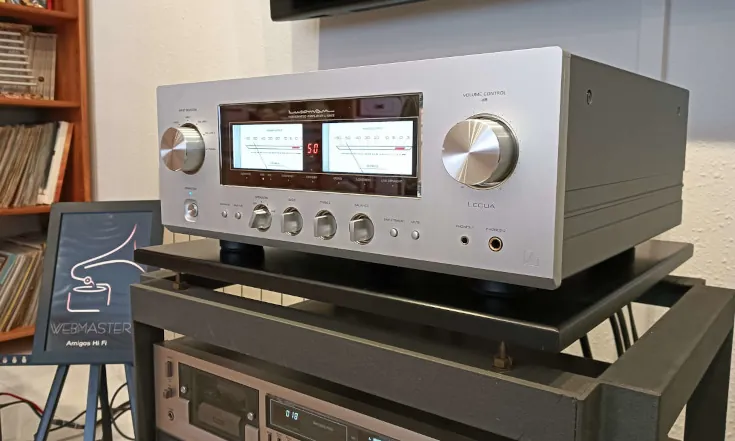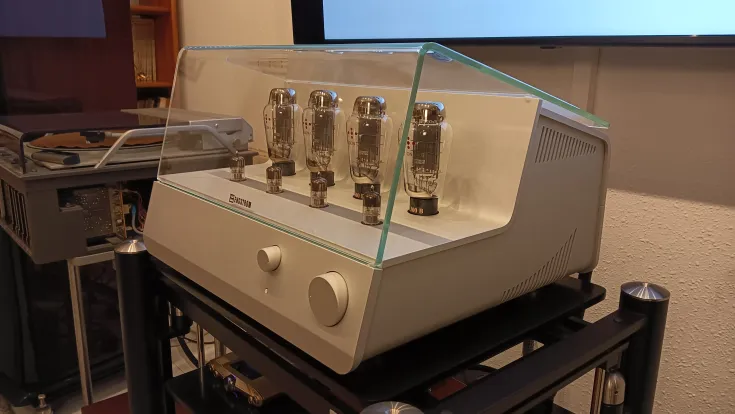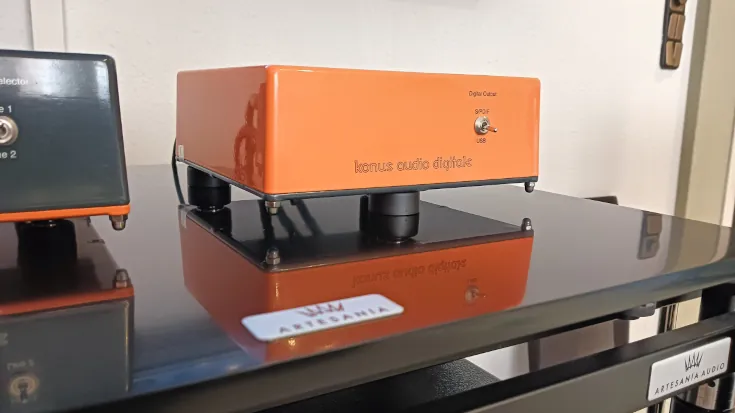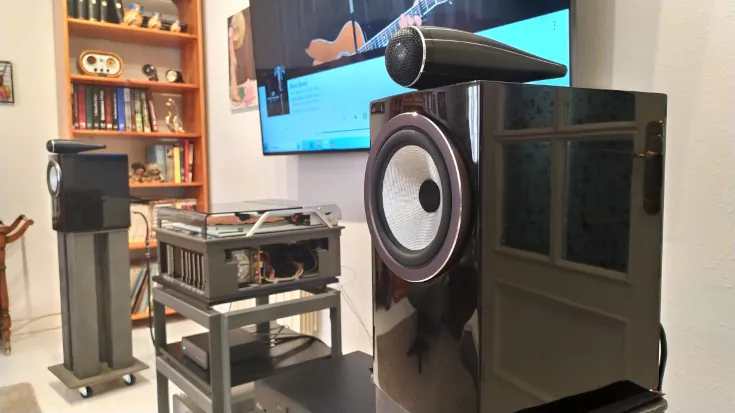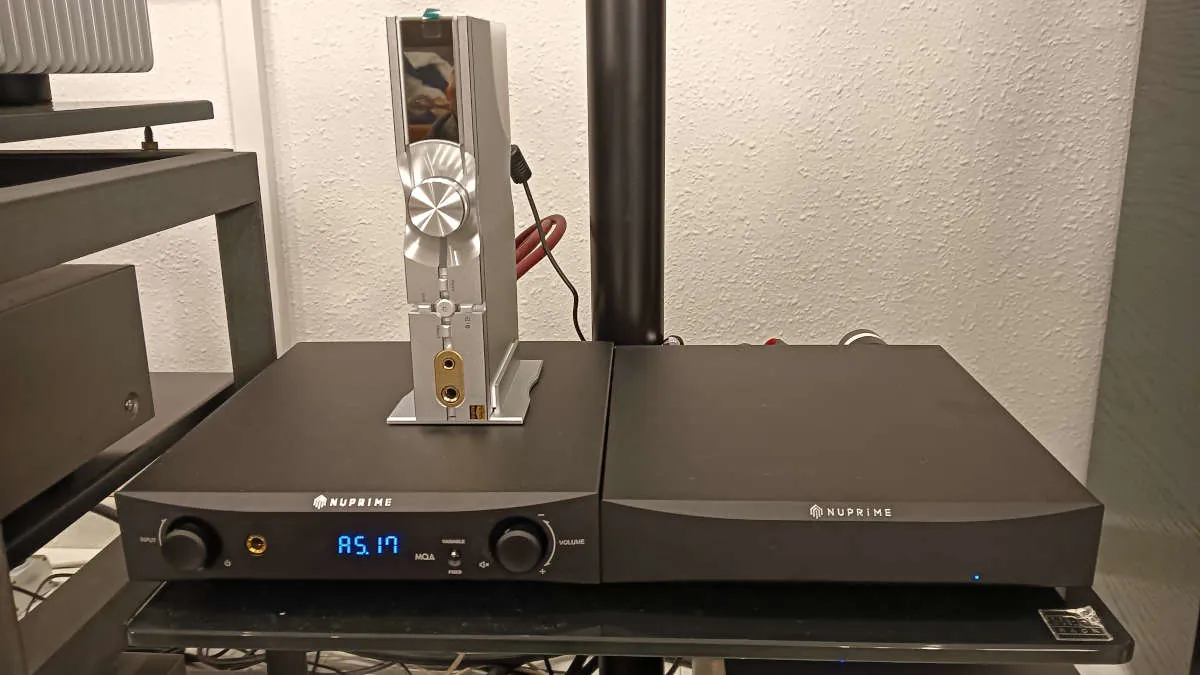
Not long ago, I wrote this article dedicated to the NuPrime DAC 9X; this article should be considered the second part of that one, since the source and preamplification are the same in both cases. To make this a little more interesting, I have installed other speakers to see what difference they make and I have a little surprise at the end. Let's get started.
In the previous article, I already talked a little about the brand, so I will skip this section and refer anyone who is interested to the DAC 9X review.
NuPrime STA 9, Class A/D
The visual appearance of the NuPrime STA 9 Stereo/Mono power amplifier follows the lines of the DAC 9X, i.e., it shares the same outer body and dimensions, making it a viable option to stack them on top of each other. This is even more so considering that the heat dissipation in these devices is reasonable and, therefore, no problems are expected in this regard.
Its basic specifications are an output power of 120 watts (W) in stereo and 290 watts (W) in mono mode, both at 4 and 8 ohms. A frequency range of 10 Hz to 50 kHz. And this data: THD+N: 0.02% (stereo) / 0.01% (mono).

On the front panel, we find... nothing. Well, not quite: there is a small blue LED to indicate whether the unit is active or not. Everything else is on the rear panel: power socket, fuse, two RCA inputs and two XLR inputs. Speaker terminals with a small connection diagram for use in mono mode. Two small switches select one of the two inputs: RCA/XLR, and another switch selects STEREO/MONO.
Class A/D
The sound entering the STA 9 is preamplified in Class A , with an ultra-linear circuit that gives the sound its characteristic color, typical of this brand. It comes from their award-winning IDA-8 , a multi-award-winning integrated amplifier, which is where they began assembling this component. To get to the point, NuPrime has a sound closer to tube than transistor. I know this feeling perfectly, as my usual reference, the Bow Technologies WAZ00 XL, is a clear example of this. And without a doubt, this has been the sound most similar to my Bow reference. Although the surprise was yet to come, this switched amplification (Class D) operates at a whopping 550 kHz. This is almost double that of most competitors in this product range, which typically operate at 300 kHz. This means it loses output power by dividing the input pulse compared to the competition, but it gains a level of precision and detail in the output signal that puts it in a different league. A higher league, considerably higher, given the price at which this power amplifier is sold.
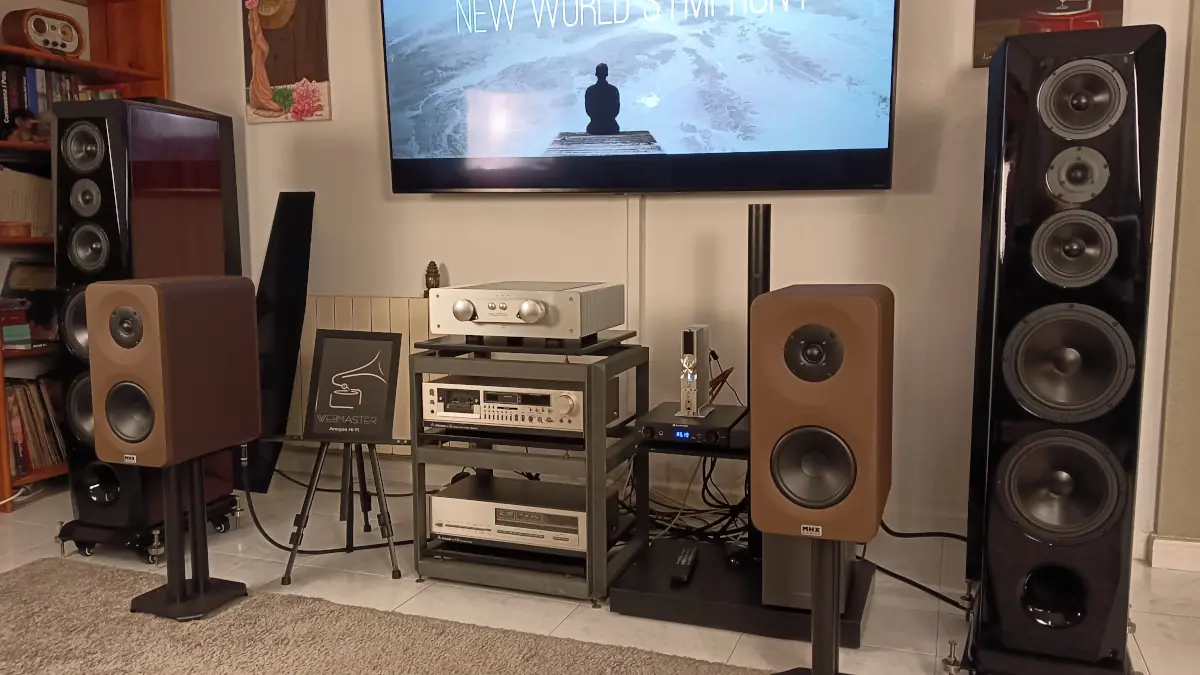
Equipment used in testing
»Sound source:
» Roon Labs on dedicated PC
» iFi Audio iDSD Neo 2
»NuPrime DAC 9X
»Power amplification:
»NuPrime STA 9
»Speakers:
»Legacy Audio Focus SE
»RadioTehnika Giant FS-100N
»MHX Audio RZ 106
»Cables:
» Wires4Music for wiring:
» Horus Hybrid RCA interconnect
»Evolution on speakers and mains
» Custom rack
Legacy Audio Focus SE
I will quote some significant excerpts so as not to repeat myself: "NuPrime DAC 9X gave me this moment of personal glory. The Legacy Audio Focus SE speakers have a nasty habit of stripping bare and revealing everything to anyone who dares to connect to them. The fundamental part is the bass control in this recording and not letting them muddy the sound; it is essential. Obviously, part of the success is due to the STA 9 , but the soul of this fine ensemble is the DAC 9X. Therefore, give credit where credit is due."

And speaking of a work by Bruce Springsteen: "My City in Ruins was created in late 2000 to denounce the degradation of Asbury Park, New Jersey. With the 9/11 attacks, it took on another meaning for the general public, and being able to "touch" the feeling in the band's voice and performance on this song, in particular, makes you touch the sky. Life isn't neat and tidy; knowing how to give music the right tone, flavor, and smell transports you to places you rarely get to."
RadioTehnika Giant FS-100N
Just as I mentioned with the Legacy speakers, another stage would have been needed to work in mono and get the most out of them, but with my RadioTehnika speakers this is not necessary. The STA 9 clearly meets their stereo needs and there is no need to resort to anything else.

Initially, I tried to stick with Bruce Springsteen, although the memory of the real party I had experienced a few days earlier with the Legacy speakers prevented me from fully enjoying the sound. RadioTehnika does not have the dynamic range of Legacy; its sound is somewhat softer in the bass and not as sharp in the high end of the spectrum, so this combination was missing... rock. So I decided to pay a visit to Prince Kalender in Rimsky-Korsakov's Shéhérazade. In the second movement, “Le récit du prince Kalenker," a slow piece with powerful entries from different elements of the orchestra, both wind and strings. The prominence of one or the other at any given moment and the dialogue between them give you nuances of their capabilities and limitations. The trumpets are not as brilliant as on other occasions, but the musical rhythm and the atmosphere created in this work are conveyed correctly, much more than correctly if I add the price of the sound to the equation.
And without leaving the princes behind, we move on to the Polish lands of Prince Igor. Borodin, in the second act of this work, with his "Polish Dances," puts your musical system to the test. From the drum beating a martial rhythm to the choirs singing at the top of their lungs, the power stage is pushed to its maximum performance. The various explosive entries in numerous fragments make it a must when testing things out. In no case has there been a lack of electrical power to cover the excess sound produced. This is determined by the fact that the frequency peaks supported by the STA 9 are well above the maximum in watts mentioned in its technical information. Alert, neighbors. Things could get out of hand. I would like to highlight, above all, the breadth of those round bass tones, which fill the room and are so present and predominant that they constantly remind you of the valve sound but with steroids to enhance the depth of the notes.
MHX Audio RZ106
I already reviewed them in their day. The configuration associated with these speakers is the one I have described a little further down, when I talk about the iDSD Neo 2. The main reason for trying this model was to evaluate its performance compared to lower-end models. And the truth is that it does improve somewhat on my previous impressions of the speakers, but they are still a bit dark in terms of soundstage presence. I'm sorry I can't be more optimistic, as I really like the manufacturer, although this may not be their best product.
And now comes the surprise I promised you at the beginning of the article. My restless personality couldn't settle for the feelings I had after the previous paragraph, I'm sorry, that's how I am. So I started an acoustic creative process. In life, there are three types of people, in my opinion: those who build, those who deconstruct, and those who destroy. I don't know how to do the first or the third, so I researched, tested, modified, and made mistakes in most cases with the second option. However, with one, the result was overwhelming. I had just created a sound that multiplied the price of these speakers by five. I called the manufacturer, asked him if he wanted to take the plunge, and we are now starting the preliminary work to create a prototype. Will it see the light of day? Only time will tell.
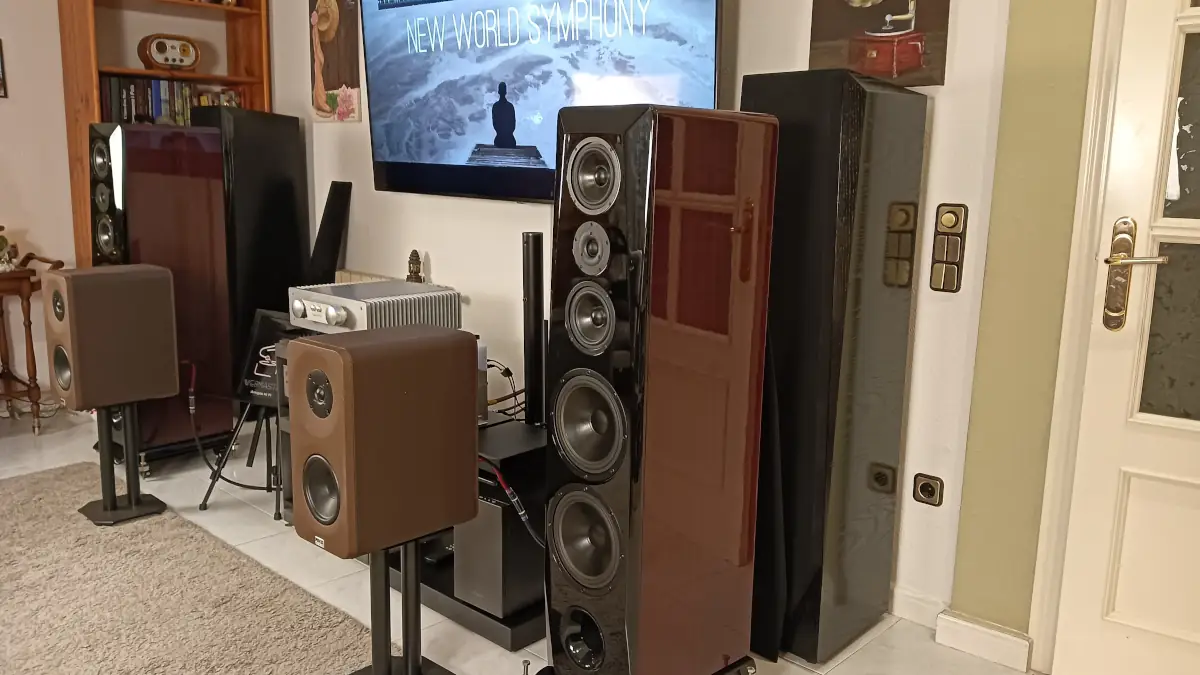
iFi Audio iDSD Neo 2
To top it all off, and taking advantage of the fact that I had the latest iDSD Neo 2 at home for a future review, there was nothing better than pairing it with the NuPrime DAC 9X for its analog input and to act as a preamp, to then connect to the STA 9 and the MHX Audio RZ106; and now we have the whole party set up at home.
Having so much equipment available means that, from time to time, you lose your mind and go crazy trying everything that comes to mind.
So that you don't get the impression that I've mentioned a device without adding anything, let me say that the iFi is radically different from the DAC 9X, giving the music more definition, which is neither better nor worse, just different. Although the nuanced sound it brings to the NuPrime will give me a lot to talk about. To be clear, I don't think that if the preamp had been Cambridge, Audia Flight, or PS Audio, the combination would have been a winner.
Conclusions
The NuPrime STA 9 is a fairly compact and heavy power amplifier that could be your gateway to reference-quality hi-fi. Gateway. One wonderful thing for people who have to be careful with their budget is that you can buy one first, running in stereo, and then another one later to run in mono. Aesthetically, it's impossible not to like it. It may leave you indifferent, but it won't bother your eyes, as is the case with other very creative designs intended for Asian markets.
Its tube tone can be used to compensate for other brighter components in the sound chain, or enhanced if we work with another NuPrime component or one with similar characteristics.
It doesn't always happen to me, but in this case it did. I feel like I enjoyed the STA 9 more at a generous volume than in my more intimate listening sessions. Its dynamics shine more than its sweetness. As I always say, there is no such thing as the perfect component, but there is the perfect component for a user. Is this yours?
Specifications
Power:
2 x 120 W / 1 x 290 W at 8 and 4 ohms
Maximum output power:
2 x 280 W / 1 x 320 W at 8 and 4 ohms
Input impedance:
47k Ohms
Input sensitivity:
232.8 mV, 1 W at 8 ohms; 1.4 V at rated power
Gain:
x 22 (x 42 for mono)
Signal-to-noise ratio:
< -95dB at 1W, 10W, 100W
Dynamic range:
-115dB at 0dB at 1kHz
THD+N:
0.02% (stereo) / 0.01% (mono)
Frequency response:
10 Hz to 50 kHz
Dimensions:
235 mm W x 281 mm D x 55 mm H (including feet)
Weight:
4.75 kg
Color:
Black or Silver
On a 110 V outlet, standby power consumption is less than 14 W. On a 230 V outlet, standby power consumption is less than 16 W.
| Manufacturer's website | NuPrime |
| Distributor Website | Hiend.es |
| Price | €1090 |
| Technical Specifications | Click here |
| User manual | Click here |
More review
-
Kii Audio Three, the master key to sound (2)
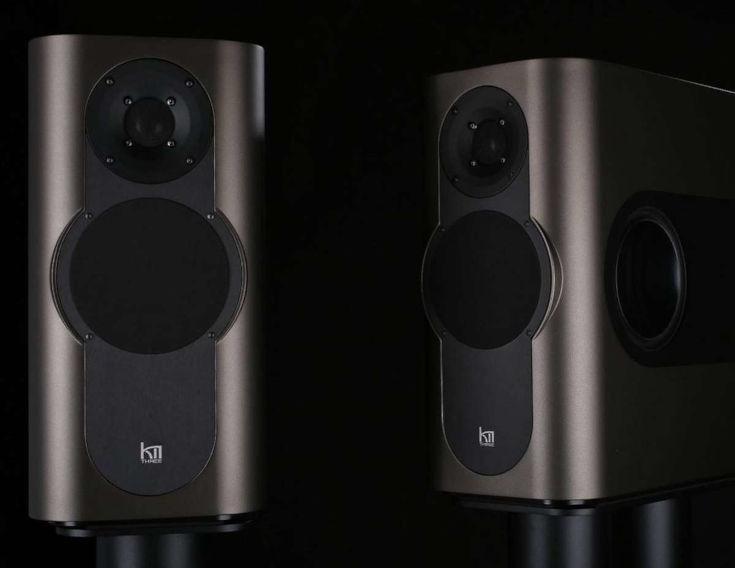
Intelligent DSP correction allows us to achieve a phase response that is identical to the original...
-
-
Legacy Audio Signature, the tenor of hell

The motorcyclist in the black jacket, with badges, chains, long beard and dark glasses has the...







